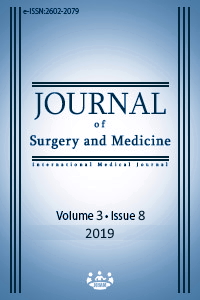Vitamin D status in infancy: What is the solution?
Keywords:
Vitamin D status, Cholecalciferol supplementation campaign, Infancy, TurkeyAbstract
Aim: Vitamin D deficiency and insufficiency are common public health problems throughout the world. Besides important multisystemic metabolic effects, vitamin D is necessary for a healthy skeletal system. Various reasons cause vitamin D deficiency in infancy, and supplementation is one of the treatment options. A nationwide supplementation program has been implemented in Turkey since 2005. In this study, we aimed to evaluate the efficacy of this program in our city.
Methods: All infants aged between one and twelve months who were referred to the pediatric outpatient clinics of the hospital and tested for serum 25-(OH)-D levels between January 1, 2015 and December 31, 2016 were enrolled in the study. Patients with chronic illnesses were excluded. Data was obtained retrospectively from the hospital registry. In accordance with the criteria of American Academy of Pediatrics, patients were divided into three groups based on serum 25-(OH)-D levels as follows: 25-(OH)-D<15 ng/ml were considered deficient, 15.1<25-(OH)-D<20 ng/ml were considered insufficient and sufficiency was defined as 25-(OH)-D>20 ng/ml.
Results: The study group consisted of 265 infants. The mean age of the group was 7.53 (2.75) months. Approximately 15% (n=39) of the study group had vitamin D deficiency, 10.5% (n=28) had insufficiency and Vitamin D levels of 74.4% (n=198) of the group were sufficient. Serum 25 (OH) D levels did not differ with gender, age or season (P=0.12, P=0.65 and P=0.09, respectively). Vitamin D levels were sufficient in 78.5% (n=150) of the urban area residents and 69.6% (n=32) of the rural area residents, between which there was no significant difference (P=0.32).
Conclusion: Our results established that supplementation is one of the ways to avoid limitations affecting serum vitamin D levels. Supplementation with 400 IU/day Cholecalciferol is provided during the first year of life by the Turkish Ministry of Health, which we believe rendered gender, age, time of measurement and residential area insignificant in terms of 25(OH) D levels. This supplementation program may solve the problem of vitamin D insufficiency or deficiency among disadvantaged groups.
Downloads
References
Sahin ON, Serdar M, Serteser M, Unsal I, Ozpinar A. Vitamin D levels and parathyroid hormone variations of children living in a subtropical climate: a data mining study. Ital J Pediatr. 2018 ;44(1):40.
Lips P. Vitamin D status and nutrition in Europe and Asia. J Steroid Biochem Mol Biol. 2007;103(3-5):620-5.
Ala-Houhala M, Koskinen T, Terho A, Koivulo T, Visakarpi J. Maternal compared with infant vitamin D supplementation. Arch Dis Child 1986;61(12):1159-63
Reeve LE, Chesney RW, DeLuca HF. Vitamin D of human milk identification of biologically active form. Am J Clin Nutr. 1982;36(1):122-6.
Antonucci R, Locci C, Clemente MG, Chicconi E, Antonucci L. Vitamin D deficiency in childhood: old lessons and current challenges. J Pediatr Endocrinol Metab. 2018;31(3):247–60.
Hatun S, Ozkan B, Bereket A. Vitamin D deficiency and prevention: Turkish experience. Acta Pediatr. 2011;100(9): 1195-9.
Ozkan B, Doneray H, Karacan M, Vançelik S, Yildirim ZK, Özkan A, et al. Prevalence of vitamin D deficiency rickets in the eastern part of Turkey. Eur J Pediatr. 2009;168(1):95-100.
Holick MF. Vitamin D status:measurement, interpretation and clinical application. Ann Epidemiol. 2009; 19(2): 73–8.
Holick MF, Binkley NC, Bischoff-Ferrari HA, Gordon CM, Hanley DA, Heaney RP, et al. Evaluation, treatment, and prevention of vitamin D deficiency: an endocrine society clinical practice guideline, J. Clin. Endocrinol. Metab. 2011;96(7):1911–30.
Misra M, Pacaud D, Petryk A, Collett-Solberg PF, Kappy M, Drug and Therapeutics Committee of the Lawson Wilkins Pediatric Endocrine Society. Vitamin D deficiency in children and its management: review of current knowledge and recommendations. Pediatrics. 2008;122(2):398–417.
Munns CF, Shaw N, Kiely M, Specker BL, Thacher TD, Ozono K, et al. Global Consensus Recommendations on Prevention and Management of Nutritional Rickets. J Clin Endocrinol Metab. 2016;101(2):394–415.
Amasya Valiliği: Amasya Genel Bilgiler: http://www.amasya.gov.tr/cografi-konum. accessed in January 2019
Amasya Valiliği. Genel bigiler. https://www.mgm.gov.tr/veridegerlendirme/il-ve-ilceler-istatistik.aspx?m=AMASYA, accessed in January 2019
Zittermann A, Gummert JF. Nonclassical vitamin D action. Nutrients. 2010;2(4):408–25.
Nicolaidou P, Hatzistamatiou Z, Papadopoulou A, Kaleyias J. Low vitamin D status in mother–newborn pairs in Greece. Calcif Tissue Int. 2006;78(6):337-42.
Mutlu GY, Kuşdal Y, Özsu E, Çizmecioğlu FM, Hatun S. Prevention of Vitamin D deficiency in infancy: daily 400 IU vitamin D is sufficient. Int J Pediatr Endocrinol. 2011;(1):4.
Gülez P, Korkmaz HA, Özkök D, Can D, Özkan B. Factors Influencing Serum Vitamin D Concentration in Turkish Children Residing in İzmir: A Single-Center Experience. J Clin Res Pediatr Endocrinol. 2015;7:294-300.
Chan KC, Tam WH, Chan MH, Chan RS, Li AM. Vitamin D deficiency among healthy infants in Hong Kong: a pilot study. Hong Kong Med J. 2018;24 Suppl 3(3):32-5.
Güven A, Ecevit A, Tarcan A, Tarcan A, Özbek N. Yenidoğan bebeklerde kordon kanı vitamin D düzeyleri. Çocuk Sağlığı ve Hastalıkları Dergisi. 2011;54:55-61.
Sachan A, Gupta R, Das V, Agarwal A, Awasthi PK, Bhatia V. High prevalence of vitamin D deficiency among pregnant women and their newborns in northern India. Am J Clin Nutr. 2005; 81(5):1060- 4.
Karagüzel G, Dilber B, Çan G, Ökten A, Değer O, Holick MF. Seasonal vitamin D status of healthy schoolchildren and predictors of low vitamin D status. J Pediatr Gastroenterol Nutr. 2014;58(5):654-60.
Akman A O, Tümer L, Hasanoğlu A, İlhan M, Çaycı B. Frequency of vitamin D insufficiency in healthy children between 1 and 16 years of age in Turkey. Pediatrics International. 2011;53(6):968–73.
Yenilmez E, Çetinkaya RA. Evaluation of initial results of naïve HIV-infected patients regarding bone health. J Surg Med. 2019;3(5):384-9.
Downloads
- 1406 2034
Published
Issue
Section
How to Cite
License
Copyright (c) 2019 Gökçe Celep, Zeynep Hülya Durmaz, Hatice Dörtok Demir, Yalçıner Erdoğan
This work is licensed under a Creative Commons Attribution-NonCommercial-NoDerivatives 4.0 International License.
















